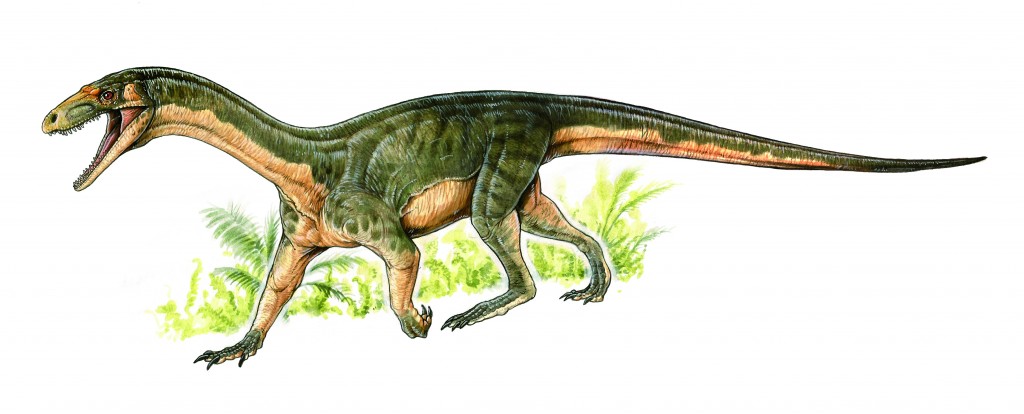Alan Charig was a dinosaur superfan long before Jurassic Park. The gregarious palaeontologist and curator at the British Museum of Natural History studied and described all sorts of new creatures, and brought them to the world through his writings and on his BBC Television show in the ’70s.
Image: Paul Barrett, Natural History Museum, London, artwork by Mark Witton.

Charig died in 1997, but scientists are finally recognising a strange dinosaur relative he named but never formally published 60 years ago. New fossils and an analysis of this 250 million year old dog-sized, four-legged, lizard-faced creature, called Teleocrater rhadinus, may seriously shake up what we understand about dinosaur and crocodile evolution.
“It’s providing a new window into what the earliest stages of the evolution of birds and dinosaurs were like,” Kenneth Angielczyk, an Associate Curator and palaeobiologist at the Field Museum, told Gizmodo. “It basically provides information similar to what Australopithecus,” our most famous hominid ancestor, “provided to human evolution.”
Famous University of Cambridge palaeontologist Rex Parrington first collected a few Teleocrater fossilised bones in the 1930s, Michelle Stocker, Assistant Professor in Vertebrate Paleontology at Virginia Tech, told Gizmodo. Charig was one of Parrington’s students, and included an analysis of the fossils and the name Teleocrater in his PhD thesis in the ’50s. But he never published his findings — he and other scientists didn’t know nearly as much about the relationship between dinosaurs, birds and crocodiles, a set of species we call “Archosaurs”, as we do today. We now know all three shared a common ancestor before splitting off into two groups, the crocodile-like group and the bird/dinosaur-like group.
The specimens remained sort of an open secret in the palaeontology community, Stephen Brusatte, palaeontologist at the University of Edinburgh, told Gizmodo in an email. Everyone knew about them, but didn’t quite know where they belonged in evolutionary history. “So many of us have seen the original specimens in the Natural History Museum in London, and have been waiting for this day.”

Image; Museo Argentino de Ciencias Naturales “Bernardino Rivadavia” (Buenos Aires, Argentina), artwork by Gabriel Lio.
Finding new Teleocrater fossils to complement those described by Charig was all luck. Back in 2015, a team of American researchers was working in a popular fossil site, the Ruhuhu Basin in southern Tanzania, exploring an area they hadn’t been to previously. They were close to giving up their search, said Angielczyk, when one of the team members headed out on his own and stumbled upon a bone bed with a ton of new Teleocrater specimens.
“As we were digging the things up it became clear that the elements were parts we’d known previously, but we were finding a lot of additional material… We had the sense it was unusual in terms of combinations of features,” said Angielczyk. They brought the bones back to the lab, where the team’s archosaur specialist realised they had found missing pieces of Charig’s Teleocrater. The original name stuck, and the researchers published their results in the journal Nature today.
“The name Teleocrater is something Alan Charig had in his dissertation,” said Stocker. They’re formalising that name in the paper. “We wanted to make sure the work he had done was to a result. His work wasn’t in vain.”

Image: Roger Smith
The new Teleocrater fossils prove this creature was part of the bird and dinosaur family, an ancestor that lived right after dinosaurs split from the crocodile-like family on the evolutionary tree around 250 million years ago. It offered some surprises, like its ankle bone. Teleocrater maintained a crocodile-like ankle bone, unlike birds and dinosaurs.
Teleocrater helps fill in a pretty big gap in the fossil record, Sarah Werning, Assistant Professor at Des Moines University who was not involved in the study, told Gizmodo. Most dinosaur and pterosaur fossils (pterosaurs are flying reptiles, technically not dinosaurs, that lived around the same time, and are about as related to birds as the dinosaurs are) only go back to the late Triassic period, and scientists don’t have fossils from the time where the two shared a common ancestor. Teleocrater was around during that time. The specimen has some features we thought were unique to later dinosaurs (and not to pterosaurs), subtle things like the shape of the hip socket and features on the vertebrae.
“It changes our understanding of when some of these features evolved,” said Werning She thought the new Teleocrater analysis might push the date of certain dinosaur features’ evolution back 50-60 million years. Some of these examples, “rather than being a dinosaur innovation, were an innovation right at the beginning of the group and pterosaurs lost it.”
It’s important to note that we’re working with very old bones, so current interpretations could always turn out to be wrong after further analysis, said Brusatte. “But regardless, Teleocrater is obviously an important animal.”
Werning thought the research highlighted the importance of museums and their vast, unanalysed collections. The American Museum of Natural History in New York has stacks upon stacks of crates from decades-old fossil hunting trips, with specimens still wrapped in the original newspaper and plaster, waiting for an interested grad student to pop them open. One of this study’s researchers, Sterling Nesbitt, previously identified a new archosaur species in the AMNH’s collection. Nesbitt also used Charig’s work to describe what could be the oldest dinosaur back in 2012.
“There’s a lot to discover in museums,” said Werning. We’re at “a time when our governments are making choices in science funding that will negatively impact the ability of museums to maintain and preserve these collections for the future.”
Just think about everything we could lose. “There’s probably, in every natural museum in the country, one undiscovered species,” she said. “Maybe more.”
[Nature]
